Wood Stove vs Pellet Stove 2025
- September 21, 2023
- 1 comment
As winter draws near, many are choosing between a pellet stove and a wood stove, both known for their efficient heating and rustic appeal. This guide for 2025 dives into each option, comparing their effectiveness, cost, and ease of use to help you determine the best fit for your home. We’ll explore how these stoves operate, their maintenance demands, and overall sustainability to assist in your decision-making process.
Fuel Source: Wood vs. Pellets
Central to the discussion between wood and pellet stoves is the distinct choice of fuel each one utilizes.
Wood Stoves

These traditional heating devices rely on seasoned firewood. As the logs burn, they exude an unparalleled magic. The vision of those glowing fibers intertwined with the rhythmic crackling sound transcends the simple act of heating a room, transporting one to memories of camping trips, family gatherings around fireplaces, and stories shared under the canopy of stars. It’s not merely about warmth—it’s about a tactile, multi-sensory experience that’s deeply embedded in human history and culture.
Pellet Stoves
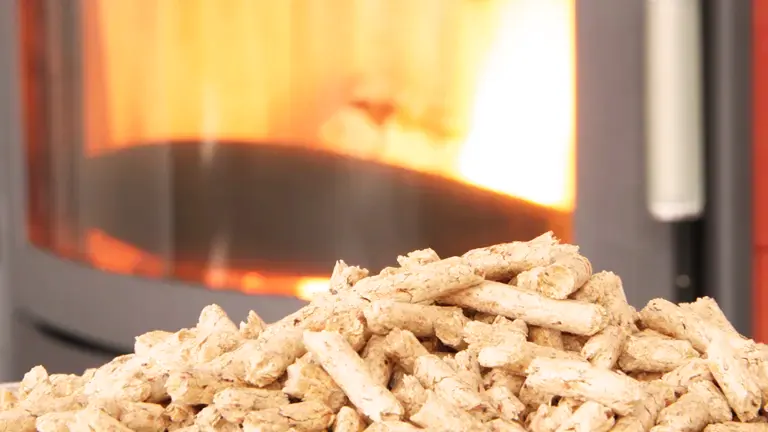
On the other end of the spectrum, pellet stoves have carved a niche for themselves as the modern eco-warriors of home heating. They burn pellets crafted from compressed wood waste, turning what might have been discarded into valuable fuel. This ingenious repurposing epitomizes sustainability. Beyond their green credentials, pellet stoves also shine in their ability to consistently and efficiently produce heat. By utilizing every fragment of the pellet, they maximize energy output and minimize waste, proving that innovation can coexist with eco-consciousness.
Emissions and Environmental Considerations
The rising tide of environmental awareness has made us more discerning in our choices, especially when it comes to our households. Home heating, a necessity for many, is no exception. When diving deeper into the ecological implications of wood stoves versus pellet stoves, there are distinctive differences that eco-conscious individuals should consider.

Pellet Stoves – The modern saviors of sustainable heating, pellet stoves, have captured the admiration of green enthusiasts. Their primary edge lies in their efficient combustion process, which leads to less ash output. This means fewer remnants and less frequent clean-ups, but more than that, it’s an indicator of how completely the fuel is burned, leaving behind minimal waste. In the realm of emissions, pellet stoves outshine with their reduced emission rates, emitting fewer airborne pollutants. They represent a step forward in eco-friendly heating, blending technology with green principles to deliver warmth without compromising the environment.
Wood Stoves – Now, when we turn our gaze to traditional wood stoves, the narrative is nuanced. While they possess an undeniable rustic appeal, they generally produce a higher volume of ash and have a larger emission footprint when compared to pellet stoves. However, it’s essential to frame this in context: wood stoves are leagues ahead in environmental friendliness when compared to some conventional heating methods dependent on fossil fuels. Utilizing the organic, renewable essence of wood, they provide warmth without leaning on depleting resources.
Heat Output and Consistency
When selecting the ideal heating solution for one’s home, understanding the balance between raw heating power and consistent temperature maintenance is essential. Wood stoves and pellet stoves, while serving a similar primary purpose, present distinct advantages in these areas.
Wood Stoves
The behemoths of the heating world, wood stoves, can radiate an impressive amount of heat. With BTU ratings that often surge past the 100,000 mark, these stoves can warm large spaces efficiently. However, there’s a catch. The intensity and consistency of this heat can be influenced by various factors, most notably the moisture content in the logs being used.
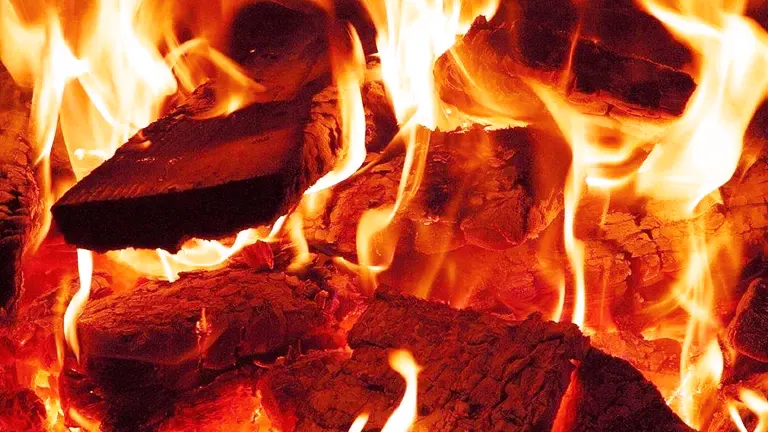
Dry, seasoned wood will burn hotter and more consistently than wood with high moisture content. Thus, while wood stoves provide a raw, elemental power, they require a more hands-on approach to ensure optimal performance.
Pellet Stoves
Pellet stoves excel in delivering a consistent heat output. Their fuel—compressed wood pellets—burns at a predictable rate, allowing these stoves to maintain a stable temperature over extended periods.
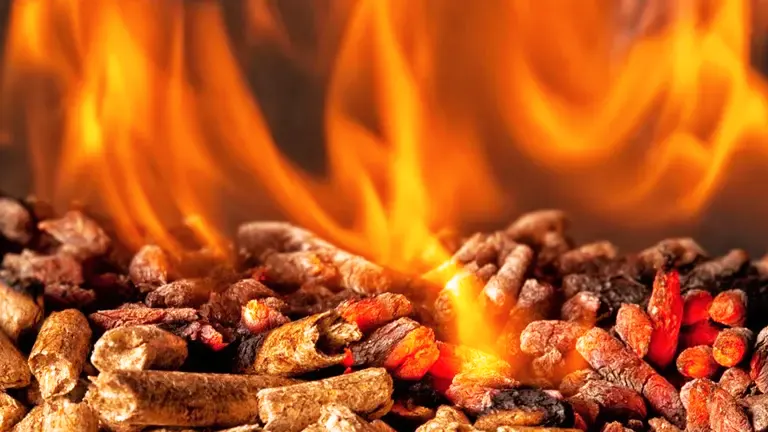
This consistency is further enhanced by technological advancements, with many contemporary pellet stove models boasting programmable thermostats. This feature offers homeowners the luxury of setting their desired temperature and then stepping back, as the stove works its magic, maintaining the perfect warmth with minimal fluctuations.
Design Choices: Inserts or Freestanding Models
The essence of interior design lies in striking a balance between functionality and aesthetics. When considering heating solutions, design versatility is paramount. Whether you’re drawn to the charm of classic designs or the sleek lines of contemporary models, both wood stoves and pellet stoves cater to a broad spectrum of style preferences and spatial needs.
Inserts
One of the most significant advantages of stove inserts is their ability to breathe new life into existing fireplaces. If you’re a homeowner with a traditional fireplace that’s seen better days or simply doesn’t get the use it deserves, an insert can be your knight in shining armor.
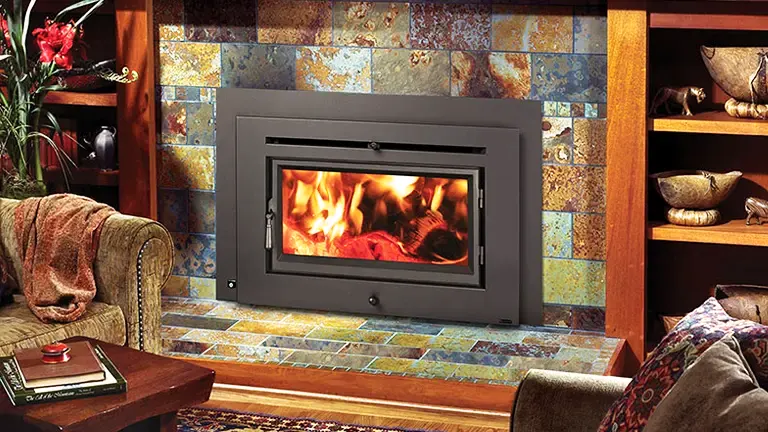
Whether it’s a wood or pellet stove insert you’re considering, these models are designed to fit snugly into the existing fireplace cavity. They not only upgrade the heating efficiency of the space but also enhance its visual appeal. Inserts act as a bridge between the old and the new, preserving the allure of traditional fireplaces while equipping them with modern heating capabilities.
Freestanding Models
These stoves, unbound by the constraints of existing structures, offer homeowners the ultimate freedom in design and placement. If your home doesn’t feature a fireplace or if you’re simply seeking more flexibility in terms of where your heat source is situated, freestanding models are your go-to.
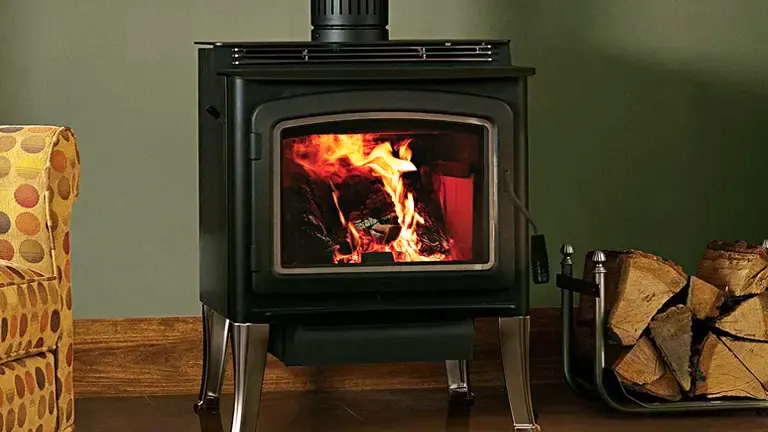
Available in a plethora of designs, from vintage to ultra-modern, these stoves can become a focal point in any room, radiating not just warmth but also style. They’re particularly suited for open floor plans or spaces where creating a cozy corner is the goal.
Durability and Maintenance
Every homeowner understands the value of an investment that stands the test of time, and when it comes to heating solutions, durability often sits at the forefront of considerations. Both pellet and wood stoves bring a unique set of advantages and challenges to the table in this regard.
Pellet Stoves
The modern marvels that they are, pellet stoves come equipped with a range of electrical components. These elements, including fans to aid in heat distribution, switches for easy operation, and motors to drive pellet feeders, work in harmony to deliver a user-friendly experience. However, like all electronic devices, these components are susceptible to wear and tear.
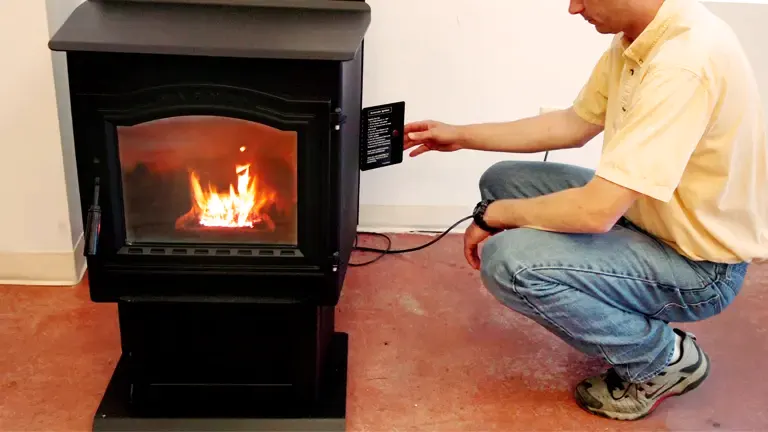
Over time, as these parts endure regular use, the potential for malfunction grows, which might necessitate periodic repairs or replacements. This technological reliance does influence the longevity of pellet stoves, often pegging their lifespan at an average of 15-20 years. Additionally, these stoves’ dependence on electricity becomes apparent during power outages, leaving homes without their primary heat source.
Wood Stoves
Taking a more rustic and elemental approach to heating, wood stoves are crafted from simplicity’s blueprint. Their design, primarily mechanical, bypasses the complex electrical systems found in pellet stoves. This stripped-down approach bodes well for durability.
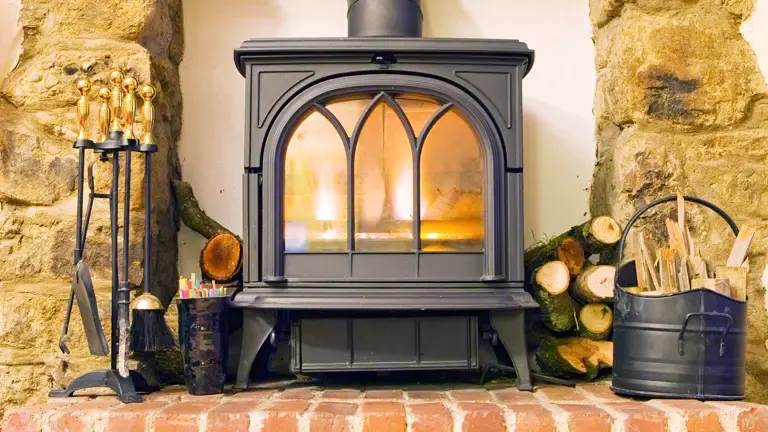
With fewer components to malfunction or degrade over time, wood stoves typically boast a longer lifespan, often stretching between 20-25 years. Their most compelling advantage, however, shines during power outages. Unfazed by electrical disruptions, wood stoves soldier on, continuing to warm homes with their natural, flame-fueled heat.
Installation Costs and Considerations
When weighing the financial considerations of installing a heating appliance, it’s essential to delve into both the initial investment and the intricacies of installation. The choice between pellet stoves and wood stoves is one that often arises, and it’s worth dissecting the costs and complexities associated with each to make an informed decision.
Initial Investment
While both pellet and wood stoves come in a variety of models with a wide range of prices, there’s a common perception that some pellet stoves can carry a heftier price tag upfront. This difference in cost can be attributed to factors like advanced automation features, electronic controls, and fuel feed systems in pellet stoves. Wood stoves, on the other hand, have a more traditional design, and while they can also be expensive depending on the model and craftsmanship, there are usually more budget-friendly options available.
Installation Complexities
The real divergence in costs becomes evident when one starts examining the installation procedures for each stove type:
- Pellet Stoves: The primary advantage of pellet stoves in terms of installation is their relative simplicity. Most pellet stoves necessitate only a direct vent. This vent usually goes out an exterior wall, making it both less invasive and less expensive. The direct vent effectively expels the combustion gases outside while drawing in the necessary air for combustion. Since these stoves don’t rely on traditional chimneys, homeowners might find savings both in material and labor costs.
- Wood Stoves: Installing a wood stove can be a more intricate process. The fundamental reason is the need for a more robust and insulated chimney system. This isn’t just a requirement for efficiency but also for safety, as wood stoves produce creosote, a flammable byproduct. To ensure that the combustion gases are efficiently vented and to prevent any fire hazards, the chimney often has to extend beyond the roof’s peak. This type of installation can be labor-intensive, and the materials for a well-insulated chimney can also be costlier.
Fuel Logistics
Fuel logistics is a crucial aspect to consider when opting for a heating appliance, as it directly impacts the user’s convenience, space requirements, and overall heating experience. Comparing wood stoves to pellet stoves provides a clear understanding of how different the two can be in terms of handling and storing their respective fuels.
Wood Stoves
- Firewood, especially when bought in bulk for the winter season, requires significant space. This space should ideally be outdoors, covered, and designed to keep the wood dry and free from pests. Depending on the stove’s size and the frequency of use, this could mean dedicating a significant portion of one’s yard or shed to wood storage.
- The wood used for burning often needs to be split into appropriate sizes. If you don’t buy pre-split wood, this can add another layer of labor to the process. Moreover, wood can leave debris like bark and splinters, which can be messy when transporting and handling.
- As anyone who has tried to carry an armful of logs can attest, firewood can be cumbersome. Carrying logs indoors can be a workout in itself, especially when done frequently. There’s also the added challenge of cleaning up the occasional trail of bark and debris left behind.
Pellet Stoves
- Pellets usually come in clean, sealed bags that are easy to stack and store. While they do take up space, it’s generally easier to allocate a dedicated storage area for pellet bags than for irregularly shaped logs. Also, the storage can be closer to the home or even inside if space allows, without much of the mess associated with wood.
- Handling pellets is relatively mess-free. They are designed to be uniform and produce minimal dust and debris. Pouring them into the stove’s hopper is straightforward, and the stove will automatically feed the pellets into the combustion chamber.
- While a bag of pellets can be heavy, it’s generally easier to manage than a bundle of logs. The bags are consistent in size and shape, making them predictable to handle. Additionally, because pellet stoves have a hopper that can store several hours’ worth of fuel, the frequency of refueling can be less than that of a wood stove, depending on the stove’s size and burn rate.
Pros and Cons
Pellet Stove
Pros
- Pellet stoves can maintain steady temperatures, and some models even come with programmable thermostats.
- They produce fewer emissions and less ash compared to wood stoves.
- Pellets are more compact and can be stored in bags, simplifying the process of refueling.
- Many models only require a direct vent, making the installation potentially more affordable than wood stoves.
- They tend to burn fuel more efficiently due to the consistency of pellet size and moisture content.
Cons
- Most pellet stoves need electricity to function, making them vulnerable during power outages.
- Typically, they last around 15-20 years, shorter than many wood stoves.
- With motors, fans, and switches, there’s a higher chance of something malfunctioning.
- While convenient, pellets might be more expensive than firewood in some regions.
Wood Stove
Pros
- Offers the classic crackling sound and appearance of burning wood.
- Many wood stoves boast BTU ratings over 100,000.
- Designed with fewer mechanical parts, they typically have a longer lifespan of 20-25 years.
- Wood stoves don’t rely on electricity, making them reliable even during power outages.
- In many areas, especially rural settings, firewood can be readily available and possibly even free.
Cons
- The heat can fluctuate based on the type and condition of the wood used.
- Firewood storage demands a significant amount of space.
- One might need to chop, season, and transport firewood.
- Wood stoves tend to produce more ash and emissions than pellet stoves.
- Without regular maintenance, creosote can accumulate in the chimney, increasing the risk of fires.
Conclusion
Choosing between a pellet stove and a wood stove is subjective, based on individual needs, preferences, and circumstances. Whether you lean towards the traditional allure of wood or the efficient consistency of pellets, ensure your choice warms not just your home, but also your heart.
FAQs
- Can I switch my existing wood stove to a pellet stove without major modifications?
While the basic idea of both stoves is to provide heat by burning wood, their designs and fuel types differ. Converting a wood stove to a pellet would require significant modifications, so it’s often more feasible to purchase a dedicated pellet stove or insert. - I’ve heard pellet stoves are more “set it and forget it”. Is this true?
Yes, many pellet stoves come with programmable thermostats that allow users to set their desired temperature. The stove will then self-feed the pellets to maintain that temperature consistently. - Are there any aesthetic differences between the flames of wood and pellet stoves?
Absolutely! Wood stoves provide a traditional, roaring fire with irregular flames, which many find captivating. Pellet stoves produce a more uniform, consistent flame, often described as a “gentle dance” of fire. - Which stove type is better for areas prone to power outages?
Wood stoves have the edge here, as they don’t rely on electricity. Most pellet stoves require electricity to operate their mechanical components, so they might not function during a power outage. - Is there a taste difference when using a wood stove vs. a pellet stove for cooking?
Some aficionados claim that food cooked over a traditional wood flame has a unique, smoky flavor. Pellet stoves offer a more consistent heat but might not impart the same traditional wood-fired taste. - I’m concerned about my carbon footprint. Which stove is more eco-friendly?
Both stoves use wood, a renewable resource, making them more eco-friendly than fossil-fuel alternatives. However, pellet stoves often have a slight edge since they burn compressed waste wood and usually emit fewer pollutants. - How do maintenance routines differ between wood and pellet stoves?
While both require regular cleaning, wood stoves often produce more ash and may have creosote buildup in the chimney. Pellet stoves, with their mechanical components, might need occasional parts replacements or repairs. - I live in an urban area. Is one stove type more suited to city living?
Pellet stoves, given their more controlled and consistent burn and reduced emissions, are often preferred in urban settings or places with stricter air quality regulations. - Can I use pellets in my wood stove or logs in my pellet stove in a pinch?
No, it’s essential to use the designated fuel type for each stove. Burning logs in a pellet stove or pellets in a wood stove can damage the unit and potentially become a safety hazard. - With the rise of smart homes, can I integrate a pellet stove into my smart home system?
Many modern pellet stoves come with features that allow them to be integrated into smart home systems, enabling users to control and monitor their stoves remotely.
Drop a comment below, share your thoughts, and let’s ignite a community discussion. Whether you’re a seasoned stove user or someone contemplating a purchase, your voice is valuable. Don’t forget to share this article with friends or family members who might be weighing their heating options for winter 2025. Together, let’s warm our homes and hearts with informed choices!

David Murray
Forestry AuthorI'm David Murry, a forestry equipment specialist with a focus on chainsaw operation. With over 13 years of experience, I've honed my skills in operating and maintaining a wide range of machinery, from chainsaws to log splitters. My passion for the outdoors and commitment to sustainable forestry drive my work, which emphasizes safety, efficiency, and staying updated with industry advancements. Additionally, I'm dedicated to sharing my expertise and promoting environmental awareness within the forestry community.













Although pellets may have a slightly lower carbon footprint than cordwood with the a similar moisture content there has to be taken into account the added carbon cost of collecting, manufacturing, packaging, (usually plastic sacks) and transportation of the pellets compared to, usually, locally sourced cordwood
Harry Figg
October 4, 2023 7:46 am